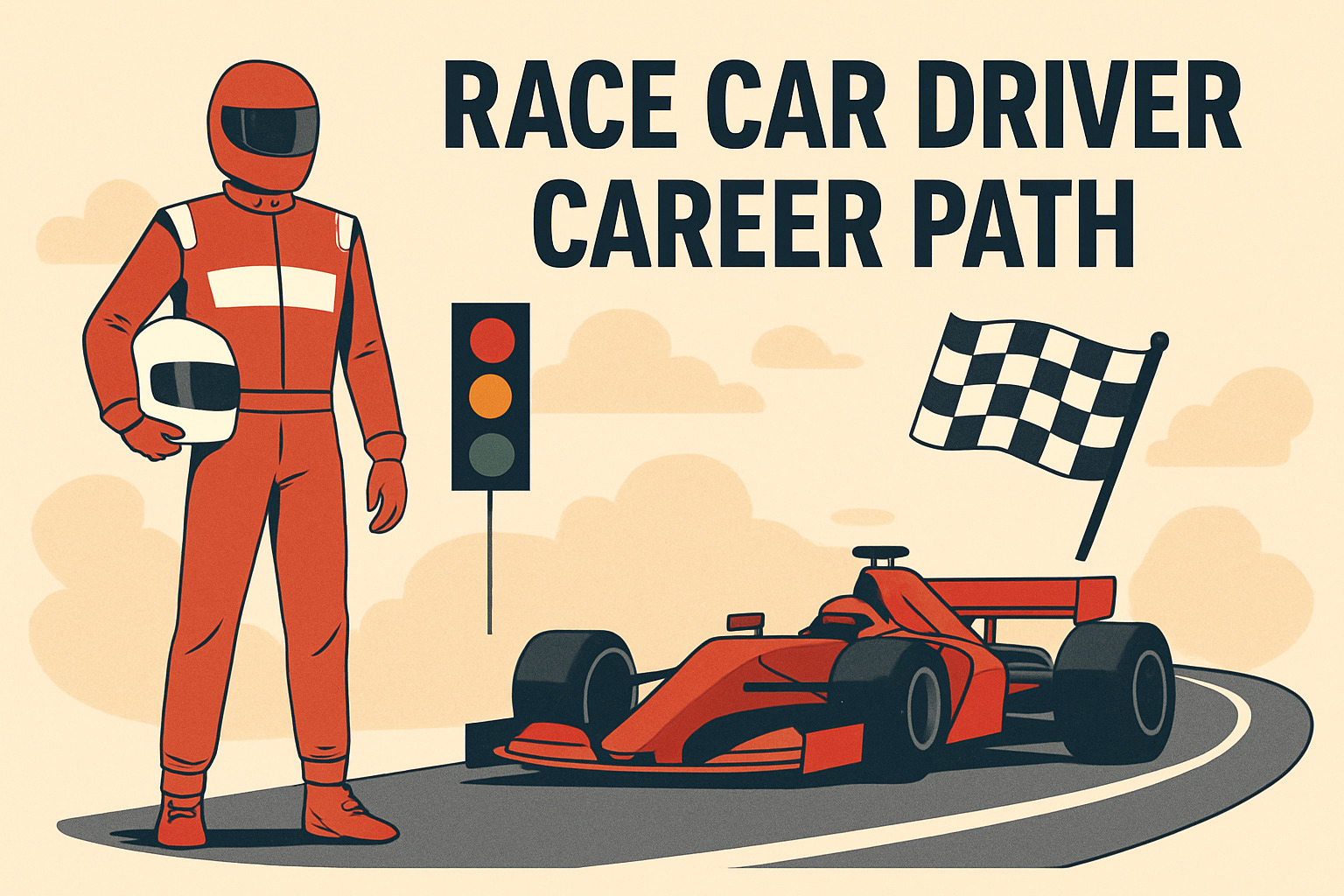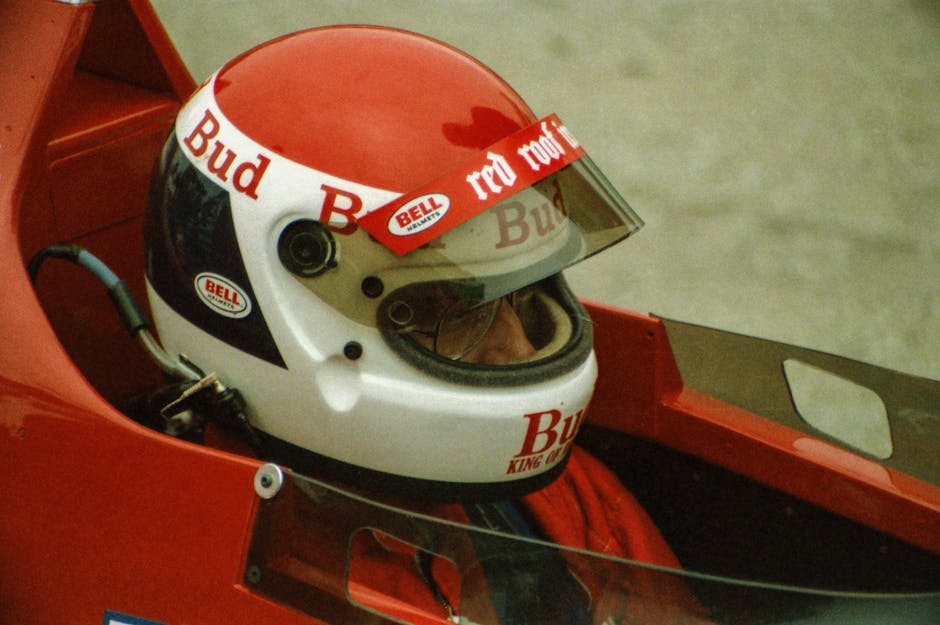race car driver career path: 7 Proven Steps to Ultimate Success 2025
The Real Road to Racing Glory
The race car driver career path follows a structured progression that starts with karting or entry-level motorsports and advances through various categories as skills, experience, and funding increase.
For those searching for a quick overview of how to become a race car driver:
- Start with karting (ages 8-14 ideal) or simulators to build fundamental skills
- Obtain racing licenses through organizations like SCCA or FIA
- Progress through racing schools and entry-level competitions
- Secure funding through sponsorships, family support, or personal income
- Build physical fitness to handle G-forces and high-stress environments
- Network with teams, drivers, and industry professionals
- Compete in increasingly competitive series based on performance and funding
As Mario Andretti once said: “I don’t remember as a kid wanting to do or be anything else but drive something, be a race driver.” This passion is the foundation of every successful racing career.
The journey to becoming a professional race car driver is one of the most challenging career paths in sports. It demands exceptional skill, unwavering dedication, substantial financial backing, and often a bit of luck. Unlike many other sports, motorsport offers extremely limited professional positions—Formula 1, for example, has only 20 seats available worldwide.
Most professional drivers begin in karting between ages 8-14, developing core skills that transfer to all racing disciplines. From there, drivers typically progress through junior formulas or club racing while obtaining increasingly advanced licenses and building both their skill set and professional network.
While the traditional path starts young, there are entry points for late starters through arrive-and-drive programs, club racing, and even simulator racing, which has become a legitimate pathway to real-world opportunities.

Mapping Your Race Car Driver Career Path
The race car driver career path isn’t a straight shot to the finish line—it’s more like a ladder with multiple entry points and branches. If you’re serious about turning your racing dreams into reality, understanding this structure is your first checkered flag.
Most pro drivers follow a journey that begins with the humble go-kart, advances through junior formulas or sports car series, and eventually reaches the professional ranks. With the right combination of talent, results, and funding, this progression typically takes 2-5 years after your karting days before you can call yourself a professional.
| License Level | Requirements | Typical Age Range | Racing Categories |
|---|---|---|---|
| Novice/Rookie | Basic theory test, medical exam, 1-3 race weekends | 14+ | Karting, Club racing, Entry-level series |
| National | 6+ novice events, consistent safe performance | 16+ | National championships, Formula Ford, GT4 |
| International | National license experience, specific series requirements | 17+ | International series, GT3, F3, Le Mans |
| FIA Super License | 40+ points from qualifying series, 18+ years old | 18+ | Formula 1, WEC top class |
Karting Foundations
Almost every racing legend’s story begins with the buzz of a kart engine. As former F1 driver David Perel puts it: “Skipping karting is like wanting to play in the Premier League without ever having kicked a football.”
Karting builds the essential skills you’ll need throughout your career: car control, racing lines, overtaking techniques, and race strategy. Most young racers start in cadet or bambino classes between ages 6-10 before moving up to junior and senior categories like Rotax Max, X30, or the more advanced KZ shifter karts.
Remember Lewis Hamilton? His father Anthony worked multiple jobs to fund Lewis’s early karting career—a sacrifice that paid off when Lewis’s exceptional talent attracted sponsors. It’s a common story in the paddock, highlighting both the commitment required and the potential rewards.
Simulators & Racing Schools
The digital revolution has created a new gateway into motorsport through high-quality racing simulators. These aren’t just games—professional teams now use simulators for serious driver training, and esports championships like the F1 Esports Series have become legitimate stepping stones to real racing careers.
“Starting with high-fidelity racing simulators helps build foundational skills safely before moving to real cars,” explains racing coach Allen Berg. The beauty of sim racing is that you can learn tracks, practice race craft, and develop technical understanding without burning through your savings on track time. For a deeper dive into this approach, check out our guide on Racing Simulator Training.
Racing schools offer another structured pathway from theory to practice. Places like Skip Barber Racing School in the US and the Winfield Racing School in Europe provide comprehensive training that can significantly accelerate your development.
Licence & Permit Checklist
Securing the right licenses is a crucial pit stop on your race car driver career path. In the US, the Sports Car Club of America (SCCA) requires you to apply for a novice permit, pass a medical exam, complete an accredited racing school, participate in at least three additional race weekends, and collect signatures from stewards to qualify for a full competition license.
The UK system involves passing the Association of Racing Drivers Schools (ARDS) test, which includes both theory (covering flags and safety protocols) and a practical assessment of your driving ability. Want to learn more about getting started with SCCA? Check out the details at SCAA license here.
As you climb the ladder, you’ll need to upgrade your license to compete in higher categories. Each signature collected at events is like a badge of honor, representing your growing experience and competence behind the wheel.
Late-Start Options in the Race Car Driver Career Path
Didn’t grow up at the track? Don’t worry—many successful drivers began their careers later in life. Take Michai Stephens, who started his journey with “a simple Google search” in his twenties. He eventually secured the Skip Barber Racing School IndyCar Academy Championship and the prestigious Team USA Scholarship.
For those coming to racing with a few more birthdays under their belt, several viable entry points exist. Autocross and track days offer low-pressure environments to develop car control. Arrive-and-drive programs provide rental race cars with technical support. Club racing series like SCCA and NASA events welcome age-diverse competitors. And simulators and esports let you build skills virtually before transitioning to the real thing.
“It’s never too late to begin your racing career,” says racing instructor Ken Howes with a smile. “The key is to be realistic about your goals and progression.” Whether you’re 16 or 60, there’s a place for you on the starting grid.
Training Like a Pro: Physical, Mental & Technical

When you picture a race car driver, you might imagine someone simply turning a wheel and pressing pedals. The reality? They’re elite athletes whose bodies and minds are finely tuned instruments. Let’s peel back the curtain on what it really takes to train like a pro on the race car driver career path.
Fitness & Nutrition
Imagine having five washing machines stacked on your body while trying to make split-second decisions at 200mph. That’s essentially what Formula 1 drivers experience with forces up to 5Gs in corners and under braking. Your everyday gym routine won’t cut it here.
“My neck used to feel like it would snap during my first few races,” shares racing instructor Mike Collins. “Now I can’t remember the last time I didn’t do specific neck training. It’s as essential as breathing.”
Professional drivers maintain incredibly lean physiques, often with body fat percentages around 8%. This isn’t about aesthetics—every extra kilogram translates to slower lap times. Their fitness regimens target the specific demands of racing: neck strength to handle G-forces, core stability to maintain position in the car, and cardiovascular endurance to manage cockpit temperatures that can exceed a sweltering 50°C.
The heat factor alone is brutal. During races in humid locations like Singapore, drivers commonly lose up to 7 pounds of fluid weight. They’re essentially competing in a moving sauna while making life-or-death decisions. No wonder their training is so specialized.
Mental Resilience & Data Analysis
The mental game in racing is just as demanding as the physical one. Picture maintaining absolute focus while processing hundreds of inputs at speeds most people can’t comprehend. One momentary lapse can have catastrophic consequences.
“The difference between good and great drivers isn’t just talent—it’s the ability to perform under immense pressure,” explains sports psychologist Dr. James Carter. “The best drivers can filter out everything except what matters in that exact moment.”
Modern racing isn’t just about feel anymore. Today’s drivers spend hours analyzing telemetry data after each session. They pore over braking points, throttle application timing, and steering inputs, hunting for those elusive tenths of a second. This technical side of mental preparation has become increasingly important with advances in technology.
Many drivers use visualization techniques before races, mentally rehearsing every corner and potential scenario. Others employ meditation and specialized breathing exercises to manage pre-race anxiety. The mental toolkit is as sophisticated as the cars themselves. For more insights into how drivers use technology to improve, check out our article on Race Car Telemetry Systems.
Technical Fluency
Understanding what makes your race car tick isn’t optional—it’s essential. The most successful drivers speak the language of engineering and can provide precise feedback that helps their teams make crucial adjustments.
“I’ve seen talented drivers stall their careers because they couldn’t effectively communicate what the car was doing,” says veteran team manager Sarah Johnson. “The driver who can tell me exactly how the suspension feels in turn three will progress much faster than one who just says ‘it doesn’t feel right.'”
As you advance on your race car driver career path, your technical knowledge needs to grow accordingly. You’ll need to understand vehicle dynamics, weight transfer principles, tire management, and aerodynamic concepts. This isn’t about becoming an engineer, but rather developing a working vocabulary that helps you collaborate with your team.
Many drivers spend time learning basic wrenching skills too. While they won’t be rebuilding engines between sessions, understanding mechanical fundamentals creates a deeper connection with the vehicle. This knowledge becomes particularly valuable when exploring Advanced Car Driving Techniques that can shave precious seconds off your lap times.
The modern race car driver is equal parts athlete, strategist, and technician. The days of the talented but undisciplined driver are long gone. Today’s professionals approach their craft with the same methodical preparation as any elite athlete—just with the added thrill of doing it at 200mph.
Budget & Sponsorship Strategy

Let’s talk money – the elephant in the racing paddock that nobody likes to discuss but everyone needs to address. The race car driver career path isn’t just about talent and determination; it requires significant financial backing that can make or break even the most promising careers.
South African GT racer David Perel puts it bluntly: “Are you willing to sell your PlayStation, your car, your couch, your TV, your watch, your shoes to become a racing driver? Because that’s what it takes.” His words capture the financial sacrifice that often accompanies the pursuit of racing glory.
Cost Breakdown & Creative Financing
The numbers can be eye-watering. A competitive karting season might set you back €10,000-€30,000 – and that’s just the entry point. Move up to entry-level formula cars like Formula Vee or F4, and you’re looking at €50,000-€150,000 per season.
The costs climb dramatically from there. A GT4 Championship season requires €150,000+, while GT3 racing jumps to €300,000+ annually. Le Mans and WEC participation? That’ll be €500,000-€1,000,000+ per season. And if you’re eyeing single-seater categories, prepare to double the equivalent GT series costs.
Professional driver Parker Thompson shares a sobering reality: “Drivers spend only 10% of their time actually driving; 90% is spent securing sponsorship.” This isn’t just a racing career – it’s an entrepreneurial journey.
Many drivers get creative with financing. Family support remains the most common solution at junior levels, but that’s not feasible for everyone. Some drivers launch personal business ventures specifically to fund their racing ambitions. Others take on flexible side jobs – driver coaching is particularly popular since it keeps you in the motorsport environment while paying the bills.
Some racers have found success with crowdfunding specific race events, while others piece together partial sponsorships from multiple smaller companies. Team partnerships where costs are shared among drivers can also make racing more affordable, though you’ll need to be comfortable sharing the spotlight.
Winning Sponsors & Scholarships
Successful drivers approach sponsorship like professional business development, not a hobby. “Racing drivers must become entrepreneurs to secure sponsorship, not rely on cold calls,” explains one marketing expert and former driver.
Building a compelling personal brand is essential. Today’s sponsors want more than a logo on a car – they want a relationship with someone who can authentically represent their values. Social media presence, content creation, and fan engagement have become crucial tools in a driver’s sponsorship arsenal.
Developing professional sponsorship proposals with clear ROI metrics shows potential partners you understand their business needs. Gone are the days when passion alone secured backing; sponsors expect measurable returns on their investment.
Networking aggressively within both motorsport and business communities opens doors. The person you meet at today’s track day might be tomorrow’s team owner or sponsor connection. Successful drivers are constantly building relationships, not just when they need funding.
Creating value-added opportunities for sponsors beyond logo placement sets you apart. Can you offer exclusive behind-the-scenes content? VIP experiences? B2B introductions? The more value you provide, the more attractive you become as a sponsorship opportunity.
Leveraging media coverage and demonstrating your reach helps sponsors justify their investment. Tracking your media mentions, social engagement, and audience demographics provides concrete evidence of your marketing value.
Junior driver academies represent another potential pathway. Programs like Red Bull’s junior team have produced multiple Formula 1 world champions by identifying talent early and providing crucial financial backing. Similarly, manufacturer scholarship programs like the Mazda Road to Indy and Toyota Racing Series can significantly reduce costs for promising drivers.
The financial problems in motorsport are substantial, but with creativity, persistence, and business savvy, they’re not impossible. As you steer the race car driver career path, your ability to secure funding often becomes as important as your talent behind the wheel – sometimes even more so.
For more insights on the business side of motorsport, check out our latest Auto Racing News for sponsorship trends and opportunities.
Picking Your Racing Discipline
The race car driver career path branches into several distinct disciplines, each with its own progression ladder, driving style, and career opportunities. Your choice should reflect your natural driving strengths, where you live, and what you ultimately want to achieve in motorsport.

Open-Wheel Fast Track
There’s something magical about open-wheel racing – those exposed wheels and sleek aerodynamic wings create the most technically demanding and often most prestigious path in motorsport. For many drivers, Formula 1 represents the ultimate dream, though IndyCar in North America offers another incredible professional destination.
Think of open-wheel as a ladder, with each rung requiring more skill, commitment, and yes – money. You’ll typically start with Formula Vee or Formula Ford, relatively affordable entry points costing between $15,000-$50,000 per season. From there, you’ll climb to Formula 4 and Formula Regional championships, where you’ll race at national and continental levels under standardized regulations.
As you progress to Formula 3, you’ll feel the thrill of higher downforce and more power while competing on international circuits. The penultimate step is Formula 2, featuring cars with a mighty 620hp, before potentially reaching the pinnacle – Formula 1, with just 20 coveted seats globally.
“Open-wheel cars are among the fastest and most challenging vehicles to control,” explains racing instructor Steve Letarte. “The safer you feel, the better you drive.”
To qualify for Formula 1, you’ll need an FIA Super Licence, which means being at least 18, holding an international competition license, passing an FIA theory test, completing 80% of two seasons in qualifying series, and accumulating 40 Super Licence points over three seasons. It’s demanding, but that’s why it’s the pinnacle of the sport. For more insight into breaking into this world, check out The Best Way to Get Into Open-Wheel Racing.
Sports Cars & GT Ladder
If endurance and teamwork appeal to you more than sprint racing, the GT (Grand Touring) and sports car path might be your calling. This discipline offers longer races, often involving team driving and endurance elements, with many professional drivers building sustainable, lifelong careers here.
Your journey typically begins with GT4 or GT Cup racing, featuring production-based cars that still feel somewhat connected to road vehicles. As you develop, you’ll move up to GT3 competition with higher performance machines in prestigious series like Blancpain GT.
The next steps include GTE/GTLM categories with factory-supported teams in endurance championships, followed by purpose-built prototype sports cars in LMP2/LMP3. At the very top sits the Hypercar/LMDh category, racing in iconic events like the 24 Hours of Le Mans.
A veteran endurance racing champion puts it perfectly: “GT racing teaches you patience and consistency over long stints. You’re not just racing for yourself but for your teammates and the entire crew.” This shared victory makes endurance racing particularly special – celebrating on the podium knowing dozens of people made it possible creates a unique bond.
Stock & Oval Pathways
The roar of V8 engines, the banking of high-speed ovals, and the door-to-door racing make stock car competition a thrilling discipline, particularly popular in North America. NASCAR and its feeder series offer substantial professional opportunities with passionate fan bases.
Most oval racers begin at local short tracks driving late models and modified cars, learning the unique craft of oval racing at the grassroots level. From there, they progress to regional stock car championships like the ARCA Menards Series, before reaching NASCAR’s three national series: the Truck Series (entry-level), the Xfinity Series (intermediate step), and finally the premier NASCAR Cup Series.
“Oval racing may look simple but it’s incredibly nuanced,” reveals a NASCAR veteran. “You’re constantly managing traffic, drafting, and tire degradation while running inches from other cars at 200mph.” The mental chess match of oval racing, combined with its physical demands, creates some of motorsport’s most exciting moments.
Each racing discipline offers its own unique challenges and rewards. The path you choose should align with your natural talents – some drivers excel at the precision of open-wheel racing, while others thrive in the endurance challenges of sports cars or the rough-and-tumble world of stock cars. Whatever you choose, commit to it fully while remaining open to opportunities that might cross your path. After all, many of today’s top professionals have competed successfully across multiple disciplines throughout their careers.
Networking, Reputation & Career Expansion

In the high-octane world of motorsport, that casual handshake in the pit lane might just be your ticket to the next level. The truth is, on the race car driver career path, your network often accelerates your career as much as your lap times do.
Building a Name Off-Track
“I spent years thinking my driving would speak for itself,” confesses GT champion Jamie Chadwick. “Then I realized that was only half the battle.”
Today’s racing drivers aren’t just athletes—they’re walking, talking media platforms. Teams and sponsors invest in personalities as much as in driving talent. That’s why developing your off-track presence is non-negotiable.
Media training might feel awkward at first, but those early interview fumbles will transform into polished appearances that attract sponsor attention. Social media isn’t just for sharing race day highlights either—it’s your personal marketing channel. The most successful drivers create compelling content that builds genuine connections with fans.
Look at Lewis Hamilton—his driving brilliance got him noticed, but his authentic personal brand built an empire. He shares his passions beyond racing, from fashion to environmental activism, making him relatable to audiences far beyond hardcore racing fans.
Remember those Q&A sessions and fan meet-ups that feel like extra work after a grueling race weekend? They’re actually golden opportunities to demonstrate your value to sponsors who want ambassadors, not just drivers with patches on their suits.
From Amateur to Professional Contracts
The holy grail in racing? That moment when teams start paying you instead of the other way around. This transition doesn’t happen by accident.
“The difference between drivers who get paid and those who pay is often what happens between race weekends,” notes veteran team principal Marcus Reynolds. Consistent results matter enormously—teams want to see you performing at the top of your current category before risking promotion. But equally important is how you handle yourself during test days and evaluation drives. These brief opportunities are your real job interviews.
When Jake Dennis landed his Formula E seat, it wasn’t just his pace that impressed—it was the detailed technical feedback he provided engineers and his professional approach to every interaction. Teams talk, and strong references from respected figures can open doors that seemed permanently closed.
The harsh reality is that many talented drivers hit a funding ceiling. When David Perel couldn’t secure the budget to advance further, he pivoted brilliantly—focusing on building relationships that eventually led to factory drives. His candidness about the financial realities of the sport is refreshing: “There are maybe 200 drivers worldwide making a living solely from driving. The rest of us have to get creative.”
Beyond the Cockpit
Racing careers rarely end with retirement—they evolve. The skills you develop as a driver create pathways to numerous roles within the sport you love.
Driver coaching has become a popular second career, with former racers passing their hard-earned wisdom to the next generation. Allan McNish transitioned seamlessly from Le Mans winner to team principal at Audi’s Formula E team, bringing his driver’s perspective to team management.
The technical understanding you develop explaining feedback to engineers can lead to fascinating careers in car development or race engineering. Darian Grubb went from the cockpit to becoming one of NASCAR’s most successful crew chiefs, showing how driving experience creates unique technical insights.
The broadcasting booth welcomes articulate ex-drivers, with Martin Brundle demonstrating how racing knowledge combined with communication skills creates broadcasting gold. His famous grid walks before Formula 1 races have become must-see TV.
“The best thing about motorsport is that it’s a community for life,” explains career transition specialist Melanie Richards. “The skills that make you valuable as a driver—technical knowledge, performance under pressure, team communication—are precisely what makes you valuable in other roles.”
Want to stay at the cutting edge of racing innovation? Former drivers often contribute to Innovative Racing Technology development, bringing real-world experience to simulation platforms and training systems.
The race car driver career path rarely follows a straight line. The most successful drivers understand that building relationships, developing a professional reputation, and considering career expansion options creates a sustainable future in the sport they love.
Frequently Asked Questions about the Race Car Driver Career Path
How much does it really cost to go pro?
Let’s talk money – because pursuing racing professionally isn’t just expensive, it’s really expensive. When people ask me about costs, I try to give them the unvarnished truth:
Starting with competitive karting, you’re looking at $10,000-$30,000 annually – and that’s just the entry point! Move up to entry-level formula racing like Formula Vee or Ford, and your budget jumps to $50,000-$100,000 per season.
The costs climb dramatically from there. Mid-level championships like F4 or GT4 require $150,000-$350,000 per season, while advanced categories like F3 or GT3 demand $350,000-$800,000. If you reach top-tier feeder series like F2 or LMP2, prepare for a staggering $1,000,000-$2,000,000 per season.
As professional driver Parker Thompson candidly shares, “90% of a driver’s job is securing funding, only 10% is actually driving.” Most racers cobble together funding through a patchwork of family support, personal income, sponsorships, and if they’re fortunate, some team or manufacturer backing.
Can I start racing after 30?
While most racing stars began turning laps before they could legally drive on public roads, starting later in life doesn’t mean you can’t enjoy a fulfilling race car driver career path – it just means adjusting your expectations.
“It’s never too late to begin your racing career,” says instructor Ken Howes, “but your goals should align with your starting point.”
If you’re starting after 30, consider these rewarding racing avenues:
Club racing through organizations like SCCA and NASA offers thrilling competition for all ages. One-make series sponsored by manufacturers often include amateur categories specifically designed for mature enthusiasts. Historic racing lets you compete seriously with beautiful classic machines. And endurance racing, with its team format, often values consistency and racecraft over the raw speed of youth.
Take inspiration from Michai Stephens, who began racing in his twenties after “a simple Google search” sparked his passion. Through determination and scholarship programs, he progressed to professional racing, proving that late starters can still build impressive careers with the right mindset.
Which licence do I need for international events?
The racing license system can seem as complex as the cars themselves! For international competition, you’ll need specific credentials based on the event level.
Starting with a National A license (or equivalent) allows you to compete outside your home country in national-level events. From there, the International C license opens doors to entry-level international racing series like GT4.
As you progress, the International B license permits higher-level competition including GT3 and F3 series. The International A license grants access to almost all top-level competitions except Formula 1, which requires the exclusive FIA Super Licence.
Obtaining an international license typically requires at least one year of experience with a national license, a consistent safety record, completion of specific events or championships, and medical certification meeting FIA standards.
The FIA Super Licence has particularly stringent requirements – drivers must accumulate 40 points from designated championships over three years and be at least 18 years old. This exclusive credential is the final gateway to Formula 1, the pinnacle of the race car driver career path.
Conclusion

There’s something magical about watching the sun set behind a podium celebration – that moment when years of sacrifice, determination, and passion culminate in triumph. The race car driver career path isn’t just challenging; it’s a life-changing journey that tests every fiber of your being.
I’ve spoken with countless drivers who describe their path to racing success as a rollercoaster – exhilarating highs followed by gut-wrenching lows. What separates those who make it from those who don’t isn’t just raw talent, but an unwavering resilience. Whether you began turning laps at eight years old or finded your passion later in life, success comes to those who adapt, learn, and persist.
The beauty of motorsport lies in its diversity. Some find their calling in the precision of open-wheel racing, others in the teamwork of endurance competition, and still others in the door-to-door battles of touring cars. Your journey might begin in karting, on simulators, at track days, or in grassroots club racing – what matters is taking that first step.
Building a solid foundation before rushing up the ladder pays dividends. As one veteran racer told me, “I’ve seen too many talented drivers skip steps and struggle because they lacked fundamental skills.” Take time to master each level before advancing.
Treat your racing as the business it truly is. The most successful drivers I’ve met spend as much time cultivating sponsor relationships and building their personal brand as they do behind the wheel. Network relentlessly – that casual conversation in the paddock might lead to your next opportunity.
Today’s professional drivers are complete athletes – physically fit, mentally sharp, technically savvy, and media-trained. Teams invest in drivers who bring value both on and off the track. As you develop your skills, being fast is just one piece of the puzzle.
Be honest with yourself about your goals and timeline. Not everyone will reach Formula 1, but that doesn’t mean you can’t build a fulfilling career in motorsport. Some of the happiest, most successful drivers I know compete in GT racing, touring cars, or club events while balancing racing with other pursuits.
Remember too that driving is just one path in the motorsport world. Many former racers find their true calling as engineers, team managers, driver coaches, or media personalities. The skills you develop as a driver – technical understanding, performance under pressure, teamwork – transfer beautifully to other roles.
At Car News 4 You, we believe in the transformative power of motorsport. We’ve witnessed how racing shapes character, builds community, and creates unforgettable moments. Whether you’re taking your first tentative laps or pursuing a professional career, we’re here to support your journey with practical advice and inspiration.
The road ahead won’t always be straight. There will be moments when you question whether it’s all worth it. But ask any driver who’s stood on that podium as the sun sets on race day – they’ll tell you there’s nothing else like it in the world.
For more guidance on your racing journey, explore our comprehensive Resource-Guide Hub, where you’ll find in-depth articles, professional interviews, and technical insights to fuel your progress. Your racing dreams are valid – now go chase them with everything you’ve got.








1 thought on “Life in the Fast Lane: Your Roadmap to a Racing Career”
Pingback: Race Car Telemetry Systems Explained: Your Secret Weapon on Track - Car News 4 You
Comments are closed.